厦大物理化学-动力学8
- 格式:ppt
- 大小:1.67 MB
- 文档页数:62
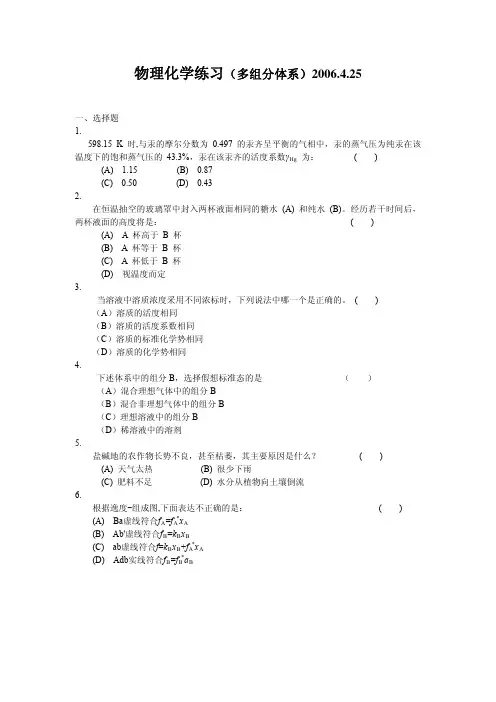
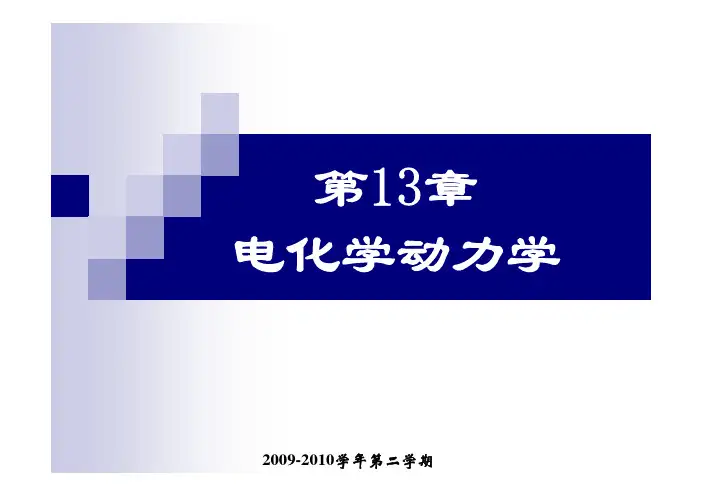
第13章电化学动力学电化学动力学和应用电化学*基本概念和术语电化学系统的动力学电解的应用*金属的电化学腐蚀与防腐*生物电化学*电化学传感器*化学电源*基本概念和术语分解电压超电势极化作用氢超电势理论分解电压使某电解质溶液能连续不断发生电解时所必须外加的最小电压,在数值上等于该电解池作为可逆电池时的可逆电动势。
理论分解可逆=E E()()分解电压的测定当外压增至2-3段,氢气和氧气的压力等于大气压力,呈气泡逸出,反电动势达极大值E b,max。
再增加电压,使I 迅速增加。
将直线外延至I =0处,得E (分解)值,这是使电解池不断工作所必需外加的最小电压,称为分解电压。
外加电压很小时,几乎无电流通过,阴、阳极上无氢气和氧气放出。
实际分解电压()()()()(())E E E IR E ηη=+Δ+Δ=+分解可逆不阳可逆不可逆阴要使电解池顺利地进行连续反应,除了克服作为原电池时的可逆电动势外,还要克服由于极化在阴、阳极上产生的超电势和,以及克服电池电阻所产生的电位降IR 。
这三者的加和就称为实际分解电压。
()η阳()η阴分解电压的数值会随着通入电流强度的增加而增加。
超电势(overpotential ,过电位)在某一电流密度下,实际发生电解的电极电势与平衡电极电势之间的差值称为超电势。
()E 不可逆为了使超电势都是正值,把阴极超电势和阳极超电势分别定义为:()η阴()η阳 (,)((,)(,)(,()))E E E E ηη==+−阴不可逆阳不平可逆阳阴阳阴平阳极上由于超电势使电极电势变大,阴极上由于超电势使电极电势变小。
()(,)()(,)),)((,E E E E ηη=−=−阳阳不可阴阴平阴不可阳逆逆平极化作用极化(polarization )当电极上无电流通过时,电极处于平衡状态,这时的电极电势分别称为阳极平衡电势和阴极平衡电势。
()E 阳,平()E 阴,平在有电流通过时,随着电极上电流密度的增加,电极实际分解电势值对平衡值的偏离也愈来愈大,这种对平衡电势的偏离称为电极的极化。
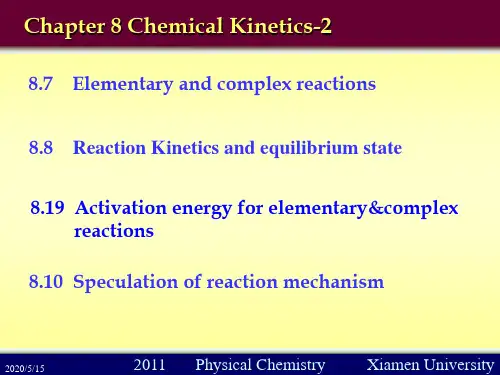
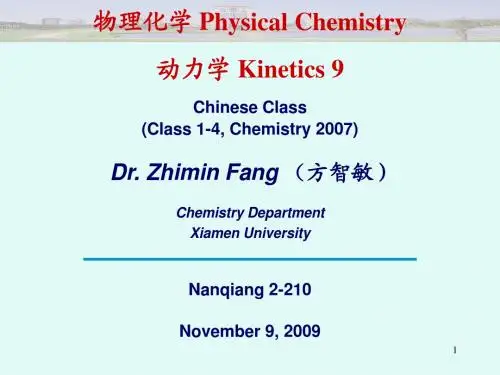
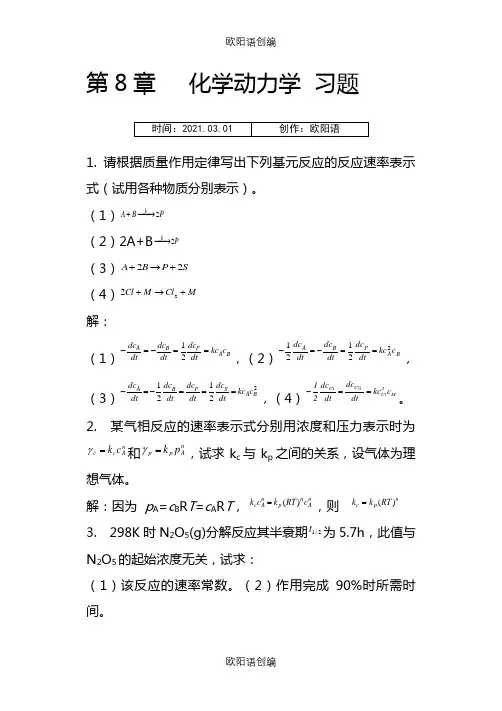
第8章 化学动力学 习题1. 请根据质量作用定律写出下列基元反应的反应速率表示式(试用各种物质分别表示)。
(1)P B A k2−→−+ (2)2A+B P k2−→−(3)S P B A 22+→+ (4)M Cl M Cl +→+22 解: (1)B A P B A c kc dt dc dt dc dt dc ==-=-21,(2)BA PB A c kc dt dc dt dc dt dc 22121==-=-, (3)22121BA S PB A c kc dt dc dt dc dt dc dt dc ===-=-,(4)M 2Cl Cl Cl c kc dt dc dt dc 212==-。
2. 某气相反应的速率表示式分别用浓度和压力表示时为nAc c c k =γ和nAp p p k =γ,试求k c 与k p 之间的关系,设气体为理想气体。
解:因为 p A =c B R T =c A R T ,n An p n A c c RT k c k )(=,则np c RT k k )(=3. 298K 时N 2O 5(g)分解反应其半衰期2/1t 为5.7h ,此值与N 2O 5的起始浓度无关,试求:(1)该反应的速率常数。
(2)作用完成90%时所需时间。
解:根据题意判断该分解反应为一级反应,因此可求得(1)12/11216.07.52ln 2ln -===h t k ,(2)hk x t 94.181216.09.011ln 11ln =-=-=4. 某人工放射性元素放出α粒子,半衰期为15min ,试问该试样有80%分解,需时若干?解:根据题意判断该放射反应为一级反应,因此可求得 (1)12/1min 04621.0152ln 2ln -===t k ,(2)min 83.3404621.08.011ln11ln=-=-=k x t 。
5.把一定量的PH 3(g)迅速引入温度为950K 的已抽空的容器中,待反应物达到该温度时开始计时(此时已有部分分解),测得实验数据如下:t /s 0 58 108 ∞ p /kPa35.0036.3436.6836.85已知反应)(6)()(4243g H g P g PH k+−→−为一级反应,求该反应的速率常数k 值。
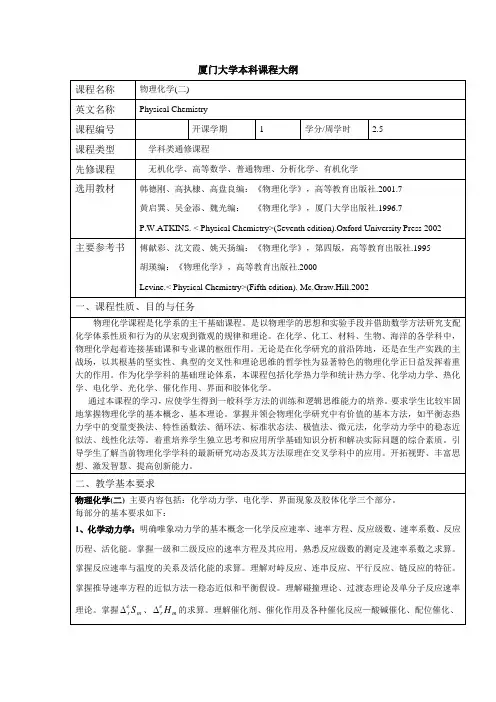
厦门大学本科课程大纲
大纲制定者:陈良坦大纲审定者:
厦门大学本科课程大纲填写说明:
1.课程中英文名称必须准确、规范。
英文名称每个单词打头字母应用大写。
2.课程类型是指公共基本课程、校通识课程、院系通识课程、学科类通修课程或学科类方向性课程。
3.先修课程是与该课程具有严格的前后逻辑关系,非先修课程则无法学习该课程。
4.选用教材和主要参考书要求注明作者、书目、出版社、出版年限。
例如,“黄叔武、杨一平编:《计算机网络工程教程》,1999年7月。
”
5.开课专业必须明确,不能出现“等”字样,如“经济学、会计学等专业”。
6.课程性质、目的和任务不少于200字。
7.教学基本要求不少于400字。
8.考核方式是指笔试(开卷或闭卷)、口试或其它考查方式。
9.其它信息是指该课程获奖情况,例如“优秀课程”、“名牌课程”、“精品课程”或者“双语教学课程”等。
获奖情况必须注明获奖等级、级别。
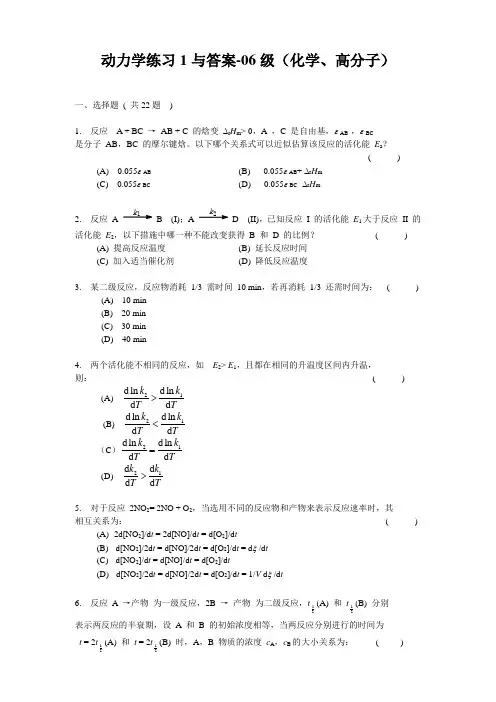
动力学练习1与答案-06级(化学、高分子)一、选择题 ( 共22题 )1. 反应 A + BC → AB + C 的焓变 ∆r H m > 0,A ,C 是自由基,ε AB ,ε BC是分子 AB ,BC 的摩尔键焓。
以下哪个关系式可以近似估算该反应的活化能 E a ?( )(A) 0.055ε AB (B) 0.055ε AB + ∆r H m(C) 0.055ε BC (D) 0.055ε BC - ∆r H m2. 反应 A k 1 B (I);A k 2 D (II),已知反应 I 的活化能 E 1大于反应 II 的活化能 E 2,以下措施中哪一种不能改变获得 B 和 D 的比例? ( )(A) 提高反应温度 (B) 延长反应时间(C) 加入适当催化剂 (D) 降低反应温度3. 某二级反应,反应物消耗 1/3 需时间 10 min ,若再消耗 1/3 还需时间为: ( )(A) 10 min(B) 20 min(C) 30 min(D) 40 min4. 两个活化能不相同的反应,如 E 2> E 1,且都在相同的升温度区间内升温,则: ( )(A)21d ln d ln d d k k T T> (B) 21d ln d ln d d k k T T< (C )21d ln d ln d d k k T T= (D) 21d d d d k k T T >5. 对于反应 2NO 2= 2NO + O 2,当选用不同的反应物和产物来表示反应速率时,其 相互关系为: ( )(A) -2d[NO 2]/d t = 2d[NO]/d t = d[O 2]/d t(B) - d[NO 2]/2d t = d[NO]/2d t = d[O 2]/d t = d ξ /d t(C) - d[NO 2]/d t = d[NO]/d t = d[O 2]/d t(D) - d[NO 2]/2d t = d[NO]/2d t = d[O 2]/d t = 1/V d ξ /d t6. 反应 A →产物 为一级反应,2B → 产物 为二级反应,t 12(A) 和 t 12(B) 分别表示两反应的半衰期,设 A 和 B 的初始浓度相等,当两反应分别进行的时间为 t = 2t 12(A) 和 t = 2t 12(B) 时,A ,B 物质的浓度 c A ,c B 的大小关系为: ( )(A) c A > c B(B) c A = c B(C) c A < c B(D) 两者无一定关系7. 当一反应物的初始浓度为 0.04 mol ·dm -3时,反应的半衰期为 360 s ,初始浓度为 0.024 mol ·dm -3时,半衰期为 600 s ,此反应为: ( )(A) 0 级反应(B) 1.5 级反应(C) 2 级反应(D) 1 级反应8. [X]0 [Y]0 [Z] 增加 0.0050 mol ·dm -3 所需的时间/ s0.10 mol ·dm -3 0.10 mol ·dm -3 720.20 mol ·dm -3 0.10 mol ·dm -3 180.20 mol ·dm -3 0.05 mol ·dm -3 36对于反应 X + 2Y → 3Z ,[Z] 增加的初始速率为: ( )(A) 对 X 和 Y 均为一级(B) 对 X 一级,对 Y 零级(C) 对 X 二级,对 Y 为一级(D) 对 X 四级,对 Y 为二级9. 连串反应 A k 1B k 2 C 其中 k 1= 0.1 min -1, k 2= 0.2 min -1,假定反应开始时只有 A ,且浓度为 1 mol ·dm -3 ,则 B 浓度达最大的时间为: ( )(A) 0.3 min (B) 5.0 min(C) 6.93 min (D) ∞10. 在反应 A k 1B k 2C ,A k 3 D 中,活化能 E 1> E 2> E 3,C 是所需要的产物,从动力学角度考虑,为了提高 C 的产量,选择反应温度时,应选择: ( )(A) 较高反应温度 (B) 较低反应温度(C) 适中反应温度 (D) 任意反应温度11. 某气相 1-1 级平行反应 M k 1R ;M k 2S ,其指前因子 A 1= A 2,活化能 E 1≠E 2,但均与温度无关,现测得 298 K 时 ,k 1/ k 2= 100,则 754 K 时 k 1/k 2为: ( )(A) 2500 (B) 2.5(C) 6.2 (D) 缺活化能数据,无法解12. 1-1 级对峙反应 12A B kk 垐垎噲垐由纯 A 开始反应,当进行到 A 和 B 浓度相等的时间为: (正、逆向反应速率常数分别为 k 1 ,k 2) ( )(A) t = ln 12k k(B) t = 11221ln k k k k - (C) t = 1121212ln k k k k k +- (D) 112121ln k t k k k k =+-13. 如果某反应的 △r H m = 100kJ ·mol -1,那么活化能 E a 将: ( )(A) E a ≠ 100kJ ·mol -1 (B) E a ≥ 100kJ ·mol -1(C) E a ≤ 100kJ ·mol -1 (D) 都可以14. A ,B 构成 1-1 级对峙反应,用 H + 催化可构成 2-2 级对峙反应,314++A B A+H B+H k k k k 垐垎垐垎噲垐噲垐 则 k 1, k 2, k 3, k 4的关系为: ( )(A) k 1= k 3, k 2= k 4 (B) k 1. k 3= k 2. k 4(C) k 1+ k 3= k 2+ k 4 (D) k 4. k 1= k 2. k 315. 若反应 A + B k k +-垐垎噲垐 C +D 正逆向均为二级反应, 则平衡常数 K 与正逆向速率常数k + , k - 间的关系为: ( )(A) K > k +/ k -(B) K < k +/ k -(C) K = k +/ k -(D) K 与 k +/ k - 关系不定16. 已知二级反应半衰期 t 12 为 1/(k 2c 0),则反应掉1/4所需时间 t 14应为: ( )(A) 2/(k 2c 0)(B) 1/(3k 2c 0)(C) 3/(k 2c 0)(D) 4/(k 2c 0)17. 某具有简单级数的反应,k = 0.1 dm 3·mol -1·s -1,起始浓度为 0.1 mol ·dm -3,当反应速率降至起始速率 1/4 时,所需时间为: ( )(A) 0.1 s(B) 333 s(C) 30 s(D) 100 s18. 均相反应 A + B k 1 C + D , A + B k 2 E + F 在反应过程中具有 ∆[C]/∆[E] = k 1/k 2的关系, ∆[C],∆[E] 为反应前后的浓差,k 1,k 2是反应 (1),(2)的速率常数。
![化学动力学总结及例题 [兼容模式]](https://uimg.taocdn.com/e3a3c087d0d233d4b14e6943.webp)
物理化学(第8、10章总结及例题)(第810章总结及例题)厦门大学材料科学与工程系材料科学与程系黄雅熙1.零级、一级、二级、三级、n级反应速率方程的特征及其应用,熟练应用速率方程式计算反应物的浓度或转化率及求值。
k2.由实验数据,应用积分法、微分法、半衰期法及隔离法等方法建立反应的速率方程,确定反应级数。
3. 阿仑尼乌斯方程的各种形式及其应用,活化能的物理意义及计算。
4.典型复合反应(对峙反应、平行反应、连续反应等)的特征及其积分速率方程的应用(主要为1-1级反应)。
5. 5.重点掌握根据稳态近似法和平衡态近似法由复合反应的反应历程推导或证明机理速率方程;推导表观活化能与基元反应活化能的关系。
6. 掌握链反应的特点及速率方程的推导。
, 7.了解催化作用的通性及单相多相催化反应的特点, 催化剂特征及作用。
8. 酶催化特征和酶催化反应的简单机理。
反应级数及反应分子数反应级数:速率方程中各反应物浓度项上的指数称为该反应物的级数;反应级数可以是正数、负数、整数、分数或零,有的反应无法用简单的数字来表示级数。
总包反应的反应级数必须通过实验测定各反应物的技术反应分子数:基元反应中实际参加反应的反应物的分子数。
只能是1、2、3分子反应。
基元反应的反应分子数等于反应级数。
一级反应的特点1.k 的特1. 速率系数k 的单位为时间的负一次方,时间t 可以是秒(s),分(min),小时(h),天(d)和年(a)等。
2. 半衰期(half-life time )是一个与反应物起始2/1t 浓度无关的常数,。
1/21ln 2/t k =3. t ln c 与呈线性关系。
A 引(1) 所有分数衰期都是与起始物浓度无关的常数。
伸的(2)1/23/47/8::1:2:3t t t =(特(3))exp(/10t k c c −=t 点0/c c 反应间隔t 相同, 有定值。
2、复合反应的动力学•对峙反应的微分式•对峙反应•对峙反应的积分式•对峙反应的特点•两个一级平行反应的微分、积分式•平行反应•两个二级平行反应的微分、积分式•平行反应的特点•连续反应的微分、积分式•连续反应•连续反应的近似处理•连续反应的c~t关系图•中间产物极大值的计算对峙反应的特点1.净速率等于正、逆反应速率之差值2.达到平衡时,反应净速率等于零3.正、逆速率系数之比等于平衡常数K=kf /kb4.在c~t图上,达到平衡后,反应物和产物的浓度不再随时间而改变连续反应的c~t关系图(1)阿仑尼乌斯方程表示反应速率与温度关系的最常用方程,阿仑尼乌斯方程特点适用于基元反应和非基元反应。
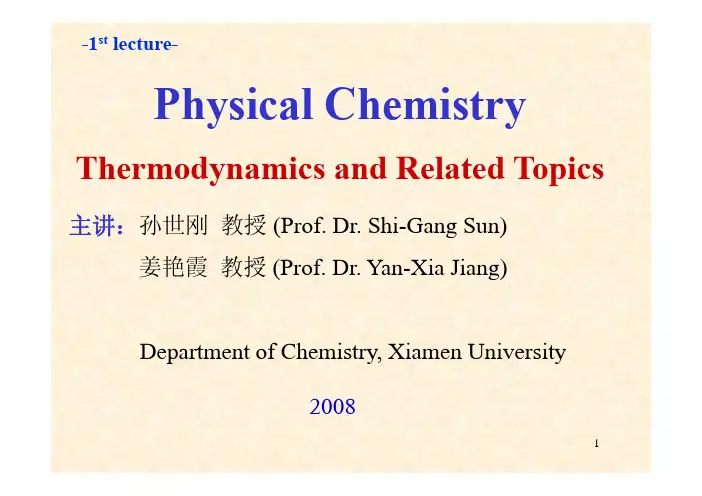
-1st lepartment of Chemistry, Xiamen University2008陈德俊h f i002@163:xuezhongfei_002@:yzjszzh@黄志忠j h@163¾教学大纲¾电子教案¾动态交流¾相关链接¾参考书目¾¾第9周中期测试•第9周至期末学习多组分体系热力学,相平衡等内容•考核:平时作业10%(每周四提交作业)中期测试40%期末测试50%Refer1.P.W. Atkins, 《Physical Chemistry》(7or 8Edition), W.H. FreemanP.W.Atkins,Physical Chemistry th or8th Edition),W.H.Freeman and Company, 1999 or 2006 (Since 1940-)2.孙世刚等,《物理化学》,厦门大学出版社,2007(普通高等教育“十一, 2002.Hill20025.韩德刚,高执棣,高盘良,《物理化学》,高等教育出版社,2001。
6.黄启圣,吴金添,魏光,《物理化学》,厦门大学出版社,1996。
7.傅献彩, 沈文霞, 姚天扬, 《物理化学》第四版,高等教育出版社,1996(1961年第一版)。
赵凯华, 罗蔚茵, 《热学》,高等教育出版社,1999。
热学高等教育出版社11.张三慧,《热学》(第二版),清华大学出版社,1999。
除重要定义外,对公式和推导过程要求从原理•除重要定义外对公式和推导过程要求从原理,而不是强记硬背上理解记忆,而不是强记硬背特别注•注意总结和领会每一部分的主要内容,特别注意使用的方法、依据的实验事实、定律或理论,•重视习题和实验•注意思维方法和逻辑推理•注意数理基础的适时复习,特别是数学知识的gual course:first thing is to study and understand the The first thing is to study and understand the contents of physical chemistry;terms and expressionsterms and expressionsI1the most general law and theory of chemical and the most general law and theory of chemical systems. Physical chemistry investigates the physical methods and introduces different and physical methods and introduces different experimental means to investigate chemical laws.2.The fuparts:gy in the change of matters (、V 、pp T 、phase and chemical changes), and the direction and limit of energetic effects (work, heat). Thermodynamics concerns the law of energy conservation and the law of matter equilibrium.(2) Quantum mechanics (量子力学)⎯that studies moving states of micro-systems.In elementary application, y y pp ,the Schrödinger equation is set up for the system and then solved either analytically or, in many-practical systems, y y ,y p y ,numerically, with due note of the boundary conditions .3)Statistical mechanics ⎯that studies 3) Statistical mechanics (统计力学)that studies the average behavior of large assemblies of particles.Statistical mechanics is the theory in which the properties of mechanics is the theory in which the properties of macroscopic system are predicted by the statistical behavior of their constituent particles.动力学)of their constituent particles.(动力学)⎯that studies the law ofinfluence of different factors such as the concentration,l l li h l i i hlyst, solvent, light, electricity, on the chemical reaction rate and mechanism (reaction details, l i )lementary reaction).Quantum chemistry(量子化学)量子化学Structural chemistry(结构化学)chemistry(催化化学) Catalytic chemistry( Electrochemistry(电化学)otochemistry(光化学)Ph h i(Chemical kinetics (化学动力学)y(热化学) Chemistry of high energy (高能化学) Computing chemistry (计算化学) Computing chemistry(pment trend ofphysical chemistry From static to transition•From static to transition•From qualitative to quantitative From equilibrium to non-equilibrium F ilib i t ilib i3. The(1) Mis thermodynamic method. Thermodynamics concerns It is thermodynamic method.Thermodynamics concerns macroscopic system that consists of large amount of particles.peculiarity of this method consists in that the method does The peculiarity of this method consists in that the method does not care the microscopic structure of particles inside matters, deals with only the macroscopic properties before andbut deals with only the macroscopic properties before and after the change of states.4. TInitiacalculationsDelivering methodology :General scientific methodology gy (materialism, epistemology, logic inference), and methodology of physical chemistry (thermodynamics, quantum mechanics, and i i l h i )istical mechanics).Importance of the methodology :It would be much beneficial toC lti ti th bilit Th bili f l i h i i l (授人以鱼,不如授人以渔)ultivating the ability :The ability of applying the principles of physical chemistry to solve practical problems.+methodology =Innovation ability5. The importance and the goal ofstudying physical chemistryhemical changes;h i l h2.Training the ability of thinking and solving;.Mastering experimental skills and methods through 3M i i l kill d h d h h experiments.main contents of the semester .Thermodynamics1Th d i. Thermochemistry2Thermochemistry. The application of thermodynamics in3The application of thermodynamics in multi-component systems. Statistical thermodynamics5St ti ti l th d iChathe state equationand the state equation1.1 Thermodynamic system and surroundings体系):The object of interest that is distinguished from its surroundings by a boundary (边界), i.e. the interface that separates . (A macro assembly that contains large number of particles) them(A macro assembly that contains large number of particles)Surroundings (环境):(=Heater(热源)+Engine(做功的机器))The that separates from the system by a physical (or an imaginary) universe that separates from the system by a physical(or an imaginary) boundary, and has close relation with the system.System Surroundings1Th l i b d di i1.The relation between system and surroundings consistsmainly in the exchange of matter and energy;particles (atoms, molecules, phonons, electrons, etc.) under specified confinement, whichmeans that the system satisfies the restriction of macroconditions, thus it can be described by macro parametersV,A,l,T, etc.);The large number means the (T,etc.The large number means thethermodynamic limit N=6.02×1023, cm3~m3;.The boundary of system may be multi-variable:it may 3The boundary of system may be multi variable it may be real, or imaginary, such as rigid wall, movable wall,diabatic wall, semi-transparent wall, etc.;di b ti ll i t t ll tS(a) An open system:can exchange matter andenergy with its surroundings.(b) A closed system:can exchange energy with itscan exchange energy with itssurroundings, but it cannotexchange matter.exchange matter(c) An isolated system:can exchange neither energy normatter with its surroundings.Open system Closed system Isolated system p y (开放体系)y (封闭体系)(隔离体系)S Mass transferringEnergy transferring SystemMass transferring between system and SurroundingsEnergy transferring (in the form of heatand work)Open yes Yes Closed No yes IsolatedNo NoCu电池电阻丝Open system Open systemO t O t电阻丝水+电池Closed systemClosed systemStationot change with time but it exists flow of matter and energy not change with time, but it exists flow of matter and energyStationary state ≠ Equilibrium stateque equilibrium state for enough long time.an particles q q g gaggregate that contains lots of particles,such as p,V ,T,U,H,S,F ,G,are named as macro characters of system (thermodynamic properties).properties ):They are not dependent of the(强度性质)y p amount of substance,and have no adding nature (e.g.p ,T ,etc.);Extensive properties :They depend on the amount ofp p (广度性质)y p substance,and have adding nature (e.g.,n ,V ,U,H ,etc.)有加和性无加和性1.3 Mstate and state functionstate and state functionMethods describing the states of a system:hod of statesh d fmechanics:Distributing probability, the statistical Statistical mechanics Distributing probability,the statistical description method of statesynamic description method or macro description method ofy p pstates)f Axiom of state (状态公理)For an uniform phase system at equilibrium, the number (F ) of independent macro properties equal the sum of the number ()f i bl b t th b ()f ibl k R ) of variable substances, the number (W ) of reversible work, and plus 1 (the energy exchanged in heat form)F R +W +1= R + W + 1e.g.1:system of uniformF =1+1+1=3, L =L T , , n),(,p ,)n 1,n 2,…n r L =L (T , p , n 1,n 2,…n r )e.g.2:system of uniformmulti substance (multi-substance l )H 2(g )T l ,p l ,n l T g ,p g ,n g H 2(l )|H 2(g )T s ,p s ,n sEquatbetweestate(热力学状态):The state that is Thermodynamic state Th t t th t i described by macro properties of system, it is also called macro stateState variable(状态变量):The independent macro properties that describe the states of system it is also called thermodynamic describe the states of system, it is also called thermodynamic variables (coordinates)that depends only on the current state of the system, and is property that depends only on the current state of the system,and is independent of the previous history of the system. That is, a state function is the function of a set of variables that define the currentΔU=0 ΔH=0ΔU=0 ΔH=01.4 TAnyT final T heater ConstantT===Constantinitial2. Constant temperature processes(恒温过程) :=Constant. Isobaric processes(等压过程):3Isobaric processesp i = p f = p ex = ConstantConstantC t t5. Iso processes:p(等容过程)V i = V f = V ex = ConstantQuasistatic processes(准静态过程) :7.Quasistatic processes)At any moment of the process the system is in equilibrium y gystem and its surroundings9. Expansion processes1.Gas is expanded to vacuumGas is expanded to vacuum(Free expansion process)G i i气体真空2. Gas is expanded againstChemical reaction processes例:合成氨反应::合成氨反应:N 2(g,1mol,723K,30MPa) + 3H 2(g,3mol,723K,30MPa)()在反应器(如合成塔)中等温等压进行反应生成分压2)在反应器(如合成塔)中等温等压进行反应,生成分压为p NH3的NH 3;将生的应离来剩余的续将生成的NH 3从反应器分离出来,剩余的N 2和H 2再继续反应,这样反复进行就能完全生成NH 3;1.5 Zertemperature)(The temperature)The Zeroth Law of thermodynamics is the justification of the concept of temperature, which is used to determine whether two systems would be in thermal equilibrium if they were in conduct through a diathermic (透热) wall, and to the direction of the resulting flow of energy: determine the direction of the resulting flow of energy: energy is transferred from high temperature to low.practice, the temperature of a system has much richIn practice the temperature of a system has much rich consequences than those are immediately obvious from this . For examples: it determines the efficiency of heat definition For examples:it determines the efficiency of heat engine, the distribution of molecules over their available energy level, the thermal conductivity of a system, etc. energy level the thermal conductivity of a system etcPreparation (预习)•3)吸热又作功的体系是封闭体系;()吸热又作功的体系是封闭体系(4)与环境又化学作用的体系是开放体系。
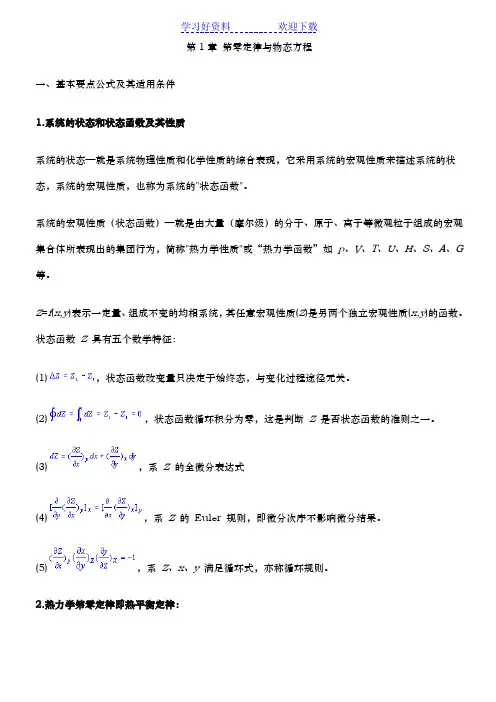
第1章第零定律与物态方程一、基本要点公式及其适用条件1.系统的状态和状态函数及其性质系统的状态—就是系统物理性质和化学性质的综合表现,它采用系统的宏观性质来描述系统的状态,系统的宏观性质,也称为系统的"状态函数"。
系统的宏观性质(状态函数)—就是由大量(摩尔级)的分子、原子、离子等微观粒子组成的宏观集合体所表现出的集团行为,简称"热力学性质"或“热力学函数”如p、V、T、U、H、S、A、G 等。
Z=f(x,y)表示一定量、组成不变的均相系统,其任意宏观性质(Z)是另两个独立宏观性质(x,y)的函数。
状态函数Z具有五个数学特征:(1),状态函数改变量只决定于始终态,与变化过程途径无关。
(2),状态函数循环积分为零,这是判断Z是否状态函数的准则之一。
(3),系Z的全微分表达式(4),系Z的Euler 规则,即微分次序不影响微分结果。
(5),系Z、x、y满足循环式,亦称循环规则。
2.热力学第零定律即热平衡定律:当两个物态A和B分别与第三个物体C处于热平衡,则A和B之间也必定彼此处于热平衡。
T =t+273.15,T是理想气体绝对温标,以"K"为单位。
t是理想气体摄氏温标,以"℃"为单位。
绝对温标与摄氏温标在每一度大小是一样的,只是绝对温标的零度取在摄氏温标的-273.15℃处,可以看出,有了绝对温标的概念后,只需确定一个固定参考点(pV)0p=0,依国际计量大会决定,这个参考点选取在纯水三相点,并人为规定其温度正好等于273.16K。
3.理想气态方程及其衍生式为:;式中p、V、T、n单位分别为Pa、m3、K、mol;R=8.314J·mol-1·K-1,V m为气体摩尔体积,单位为m3·mol-1,ρ 为密度单位kg·m-3,M 为分子量。
此式适用于理想气或近似地适用于低压气。
4.理想混合气基本公式(1)平均摩尔质量;式中M B和y B分别为混合气中任一组份B 的摩尔质量与摩尔分数。
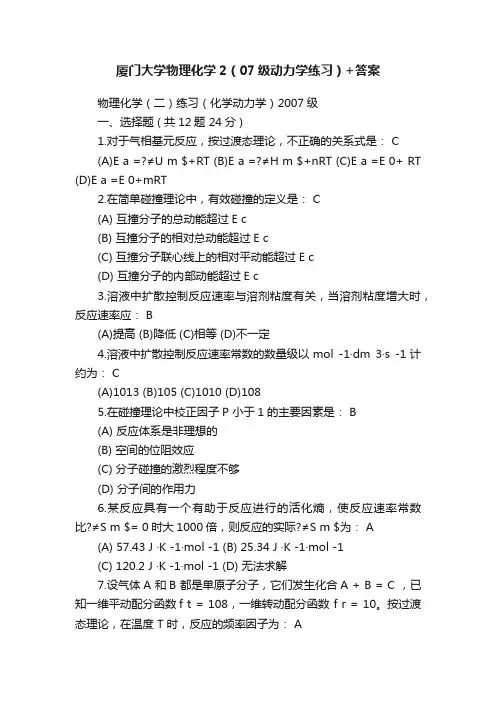
厦门大学物理化学2(07级动力学练习)+答案物理化学(二)练习(化学动力学)2007级一、选择题 ( 共12题 24分 )1.对于气相基元反应,按过渡态理论,不正确的关系式是: C(A)E a =?≠U m $+RT (B)E a =?≠H m $+nRT (C)E a =E 0+ RT(D)E a =E 0+mRT2.在简单碰撞理论中,有效碰撞的定义是: C(A) 互撞分子的总动能超过E c(B) 互撞分子的相对总动能超过E c(C) 互撞分子联心线上的相对平动能超过E c(D) 互撞分子的内部动能超过E c3.溶液中扩散控制反应速率与溶剂粘度有关,当溶剂粘度增大时,反应速率应: B(A)提高 (B)降低 (C)相等 (D)不一定4.溶液中扩散控制反应速率常数的数量级以mol -1·dm 3·s -1计约为: C(A)1013 (B)105 (C)1010 (D)1085.在碰撞理论中校正因子P 小于1的主要因素是: B(A) 反应体系是非理想的(B) 空间的位阻效应(C) 分子碰撞的激烈程度不够(D) 分子间的作用力6.某反应具有一个有助于反应进行的活化熵,使反应速率常数比?≠S m $= 0时大1000倍,则反应的实际?≠S m $为: A(A) 57.43 J ·K -1·mol -1 (B) 25.34 J ·K -1·mol -1(C) 120.2 J ·K -1·mol -1 (D) 无法求解7.设气体A 和B 都是单原子分子,它们发生化合A + B = C ,已知一维平动配分函数f t = 108,一维转动配分函数 f r = 10。
按过渡态理论,在温度 T 时,反应的频率因子为: A(A) 10-22k B T /h (B) 10-21k B T /h (C) 10-23k B T /h (D) 1023kB T /h8.光化学反应A2+h ν →2A的反应历程为:A2+h ν →A2* A2*k 12AA2*+A2k 22A2可得:r =k 1I a /(k 1+k 2[A2])则该反应之量子产率Φ为 C(A) 1 (B) 2(C) k 1/(k 1+k 2[A2]) (D) k 2/(k 1+k 2[A2])·29.相同分子B 反应,其单位时间,单位体积内的碰撞数为: C(A) 2d B 2(πRT /M B )1/2 (B) 12d B 2(πRT /M B )1/2 (C) 2N B 2d B 2(πRT /M B )1/2 (D) 4LN B 2d B 2(πRT /M B )1/2式中L 是阿伏伽德罗常数,N B 是B 分子的数密度。